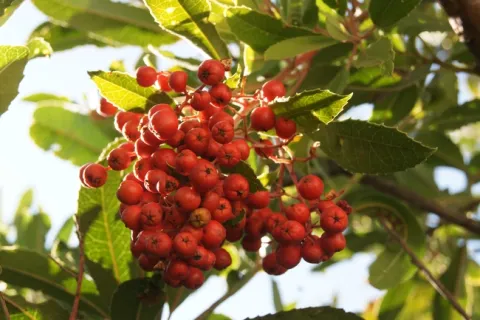
Toyon - Christmas Berry
By Jutta Thoerner UCCE Master Gardener
Heteromeles arbutifoila
Size: 6-8 feet high, 4-5 feet wide
Bloom: white flowers in summer, red berries in winter
Pruning needs: tolerates only light pruning or shaping.
Exposure: full sun to full shade.
Water needs: drought tolerant and fire resistant
USDA: zone 7a to 11
If you live anywhere on the Central Coast, you can find the evergreen toyon tree. This under-utilized native species is adaptable to most soil conditions, from sandy to adobe soil. It is a native of our coastal areas and can be found growing ½ mile from the beaches and under the shade of our oaks woodlands in North County. It is an easy to grow shrub, attractively multi branched, hardy to 0 degrees, and if protected in a wooded environment, down to -5. It only needs water the first three years, then prefers no additional irrigation. If water is supplied, it needs good soil drainage. Leaf fungal issues can arise if planted near the coast and airflow is not sufficient to allow foliage to dry after morning mist or fog.
Toyon is a good choice for a windscreen or as a privacy hedge. Plant alone or with coffee berry or Manzanita. Its abundant clusters of small, white five-petal flowers will attract pollinators (butterflies love them) in the summer and many birds such as cedar waxwings, quail, towhees, western bluebird, robins, mockingbirds and band-tailed pigeons. Because of this, it qualifies as a habitat plant for the garden. Toyon has also proven to be deer resistant, if not watered, and fire resistant. Toyon berries are poisonous to humans, containing a cyanide compound that can only be eliminated if the berries are cooked. Use the foliage and red berries in festive arrangements, wreaths or table decorations for the holidays. Consider the versatile toyon for your drought tolerant landscape.

